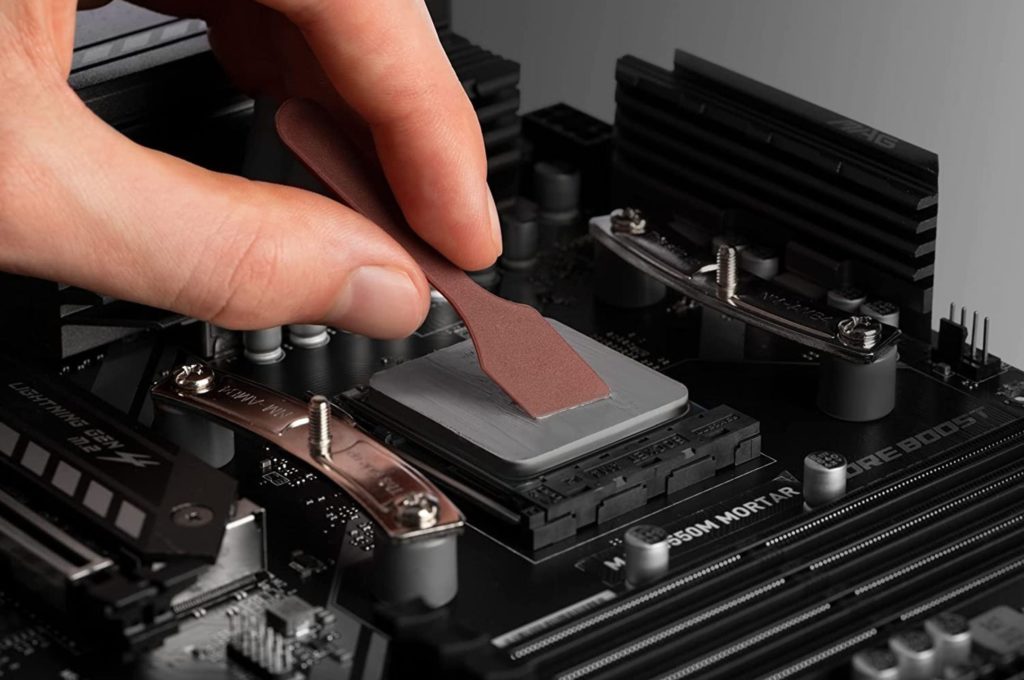Noctua NT-H1 SW – spatula plus cleaning wipes
Noctua has quietly, almost secretly, added a new package of NT-H1 thermal paste with the additional designation SW. These are the initials of the English words spatula and wipes. It is with this accessory that the NT-H1 SW pack is supplemented. And in particular, the addition of the spatula raises the question of whether Noctua has revised the recommended technique in applying thermal paste.
The correct technique of applying thermal paste is an eternal question. Is it better to spread the paste over the entire surface of the CPU heat spreader or does it make more sense to put a drop in the middle? In our tests, in which we also practiced with different amounts, applying the paste in an X shape proved to be the most effective overall. Naturally, results can vary from surface to surface, and depending on the specific situation (type of base, its surface, or the viscosity of the paste), something a little different (different technique with a different amount of TIM) may always show up at its best.
Noctua, for its NT-H1 paste on its bases (a full, gently convex block with deliberate traces of concentric circles), encourages the use of the drop method in the manuals (and we assume not just because there hasn’t been a spatula supplied with the paste until now). That is, a technique where a small droplet with a diameter of 4–5 mm is squeezed onto the centre and then squashed by the cooler base during mounting.
In the above manner, the thermal paste spreads very naturally, and although it may happen that with smaller quantities that it does not reach the corners completely, this does not matter in principle. There, the heat transfer intensity is already quite low. Still, “round” corners don’t look so good, which is probably why a lot of people resort to smearing paste all over the CPU heat spreader.
From a heat transfer efficiency perspective, spreading the paste over the entire surface may or may not be the ideal technique. It is ideal if the applied layer is perfectly smooth, thin and at the same time the contact areas are perfectly filled. However, any of these can be unsuccessful. It is virtually impossible to apply a flawlessly smooth layer with a spatula without gaps because of the smaller width and the fact that the application and surface fine-tuning is carried out in strips. And therefore, there are always imperfections between the strips, and the higher the viscosity, or the denser the material of the thermal paste, the greater the imperfections.
NT-H1 can be classified as a medium viscosity paste. Of course, the result is always better than applying the paste in the form of impressions (with a finger in a bag), but even so, spots with air bubbles may occur locally. Especially on the bases of coolers polished to a mirror effect.
The surface of Noctua bases is more immune to air bubbles, this is because of the fine grooves through which unwanted air is nicely pushed out. When trying to create a perfectly thin layer when applying the paste over the entire surface, it can still happen that in some places the contact will be imperfect due to a larger gap than the applied layer is able to squeeze out. This is both because of unevenness on the processor IHS and on the surface of the cooler base itself, where the centre is slightly convex for more intense pressure at the point with the greatest heat exchange.
In contrast, with the droplet method, the paste gets naturally to where it is needed. And even if the area is 98 % covered (because there will be some definite blind spots in the corners), the heat transfer can still be more intense than after laboriously spreading the paste over the entire area.
Therefore, to say something like “forget the droplet method” on the occasion of the spatula being added to the NT-H1 accessory range is a bit misleading. Even Noctua doesn’t claim this, but there are articles that mention the NT-H1 SW in this way. When the opportunity arises, we’ll certainly ask Noctua about this move, but it seems to be only to accommodate customers who prefer to apply thermal paste by spreading it all over the IHS.
The original NT-H1 package, which contains only the paste, will continue to be sold. The new pack is priced at 10 EUR and is about 3 EUR more expensive, and in addition to the spatula, it also contains three wet wipes. With these, Noctua is obviously trying to meet the needs of users who do not normally have a bottle of isopropyl alcohol on their shelf.
English translation and edit by Jozef Dudáš
